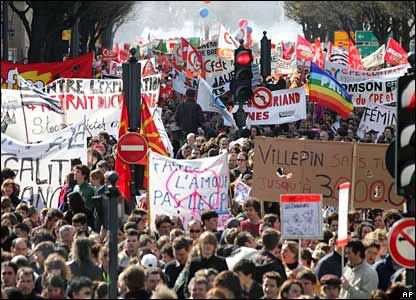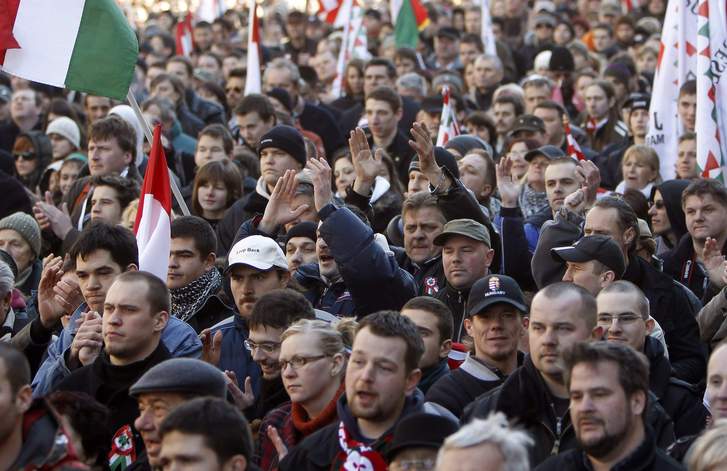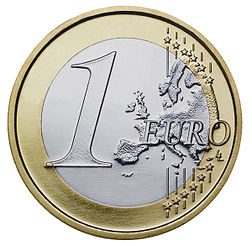|
Political participation
While what Kubicek does in chaps 8-9 is fine for a survey, a lot of what he covers in these chapters is developed in greater depth and more systematically in Dalton's book which we take up next.

French students protesting new labor law
Cleavage
The concept of political cleavages, and their role in structuring political conflict, is vital to understanding political behavior across political systems, and so I am lifting material from my introduction to political science class to provide background material to appreciate political participation in Europe.
Every political system with which I am familiar is characterized by a cleavage or multiple cleavages
- A cleavage is a metaphorical line which divides members of the community into sides
- Cleavage lines are founded on values
- In some political systems, class is the dividing line, with members of the working class at odds with members of the middle class over inequalities in wealth and the workings of the status system
- Social class, mainly the province of sociologists is also called socioeconomic status and is typically thought of as a compound of education, occupation, and income
- For a long time, class was the principle line of cleavage in states like Britain and Sweden
- George Bernard Shaw's Pygmalion, later musicalized as My Fair Lady, was largely about the social significance of class differences
- Data on the relationship between social class and voting choices suggest that class has become less important, but not without influence, in Britain (as is also the case in Scandanvia [Hoel & Knutsen, 1989])
- Other political systems are characterized by other types of cleavage
- In some political systems (Lebanon, for example, where the system is divided among Shi'a Muslims, Sunni Muslims, and Maronite Catholics) there is what is called sectarian cleavage; another example of a sectarian cleavage, where people of one faith community are, or have been, at odds with those of another faith community, is the Catholic-Protestant cleavage in Northern Ireland
- As opposed to the sectarian kind, a different type of religious cleavage is one which pits those who are religious against those who are secular, the religious-secular kind of cleavage being one in which the issue is whether religious principles should be enacted into law; Italy, where 90% of the population is Catholic at least in name, is divided between those who prize the political contributions of the Church and those who want to keep religion and church authorities out of politics; in Israel, there is a division between religious Jews, who think the state should reflect Jewish law, and secular Israelis
- A language cleavage is found in Belgium with Flemish-speaking Belgians in the north (aka Flanders) and the French-speakers of Wallonia in the south
- Region is another type of cleavage, sometimes based on geographical orientations (north v south, east v west) but more often urban v rural (or, as it is also termed center v periphery); examples here might include Japan, Mexico, and Canada
- There is also evidence in some political systems of generational cleavage where younger citizens are more committed to what are called postmaterialist values (such as free expression and environmentalism) while older citizens are more materialist(placing heavier emphasis on things like maintaining order and promoting economic growth); Germany is sometimes cited as an example
- Conceptually distinct from "simple" language, regional, and sectarian cleavages are ethnic cleavages, situations in which the community is divided on the basis of ethnicity, where an ethnic group is defined as a group of people sharing the same culture based on geographic point of origin, language, religion, practices; Nigeria, the former Soviet Union, and the former Yugoslavia are examples of systems marked by ethnic cleavage
- at this point, I want to strongly suggest to you that you abandon the idea of race altogether and get used to the concept of ethnicity instead; increasingly social and physical scientists are arguing that race is a meaningless concept, especially if one thinks of it in biological (blood or, to be more sophisticated, genetic) terms; being black or Hispanic or Asian or white is not a matter of biology (which the concept of race has tended to suggest) but a matter of how individuals identify themselves socially or how other identify them socially
- Note what are not cleavage lines
- Specific issues--such as gun control, tax policy, guest workers and immigration policy, the privileges of religious authorities, and so forth--are not the bases for cleavage, but they may well be indicative of the fundamental value conflicts which do constitute the line(s) of cleavage in a particular system
- Political parties are the not bases of cleavage in that people do not value the Christian Democrats or the Socialists per se; rather, political parties organize to compete in elections around cleavage lines, and so voters prefer the Christian Democrats or the Socialists because of the cleavage side these parties represent
- I would also argue in the same vein that ideology, understood as (contemporary) conservatism vs (contemporary) liberalism vs democratic socialism, etc., is not a cleavage line, but that citizens embrace one view or another because it supports the side of the cleavage (be it religion or class or region) to which they belong
- In thinking about how political systems differ in terms of cleavage, we are interested not only in the type of cleavage, but in what might be called the cleavage structure which includes the following aspects for any political system
- The type of cleavage, be it ethnicity, religious v secular, class, or another of those identified above;
- The number of cleavages, whether there is a single line of conflict that divides the community or there are multiple lines of cleavage and, if multiple,
- Whether the multiple lines overlap such that two or three lines reinforce the division of sides into the same blocs (old Yugoslavia--where Croats, Serbs, and Bosnians were divided into three warring camps by religion and region and eastern or western orientation--is an example) or are crosscutting (as, for example, in Germany where there is a class cleavage and a Catholic-Protestant cleavage but where there are working-class and middle-class Catholics and working-class and middle-class Protestants); and
- The intensity of cleavage, one striking measure of which is the number of political deaths, as for example in Northern Ireland during the worst of "the Troubles," Rwanda, and Bosnia
Linkage institutions
All modern political institutons need linkage institutions to perform the essential communications function whereby citizens can expess their political demands to political leaders and through which leaders can express their intentions to citizens to solicit their support. In a nation of 1 million people, let alone 61 million people, it is obviously impossible for politicians and citizens to engage in one-to-one political exchanges, and so mass democracies develop linkage institutions to aggregate (bundle together) the views of like-minded people and to articulate them on their behalf. (This kind of language is drawn from a central, conceptual work of Almond and Powell, Comparative politics [1966].) While elections and mass media are recognized as linkage institutions--means by which citizens and leaders are connected--for our purposes now we want to focus on two other types of linkage institutions, poltiical parties and interest groups; social movements are akin to interest groups but have a distinct character.
Borrowing from my website for my introduction to poltiics class--
- A political party is an organization which aims to put its members into government offices
- From this definition, the principal function of a political party is electoral, to get their members elected (or appointed) to positions of government power; it is the exceptional party that doesn’t dissolve after repeatedly failing to win power
- Political parties also have secondary functions
- They organize like-minded people in and out of government
- Out of government, people who share similar political views are likely to become active in a party as a vehicle to secure their objectives
- In government, elected and other officials frequently collaborate together for common ends
- In the Austrian legislature, members of the Social Democratic Party vote together as a bloc to support their party leader who is Chancellor (prime minister)
- In making appointments to the courts and to administrative agencies, US presidents appoint people from their own political party as a way to promote their policies
- They provide information to citizens, many of whom don’t closely follow politics; the party name or label, itself, is often enough information for citizens to decide how to vote or how to feel about a particular policy or development
- They identify and train future political leaders
- Because political parties are principally electoral organizations, they are more interested in winning elections than in taking clear stands on issues (because clear stands run the risk of alienating potential voters); as a result, people form interest groups to advance their positions
- An interest group is a group of people with a common interest who organize to influence government policy
- Women, farmers, hunters are not interest groups
- The National Organization of Women, the American Farm Bureau, and the National Rifle Association are interest groups
- To stress the point, the principal goal of political parties is to win government offices while the principal objective of interest groups is to get their policies adopted by government
- Because parties want to win control over government offices--one way of phrasing it is to say that they are “vote sucking” machines--they are inclusive in that they make it easy for citizens to affiliate with the party (in the US, for example, all one needs to do is to say “I’m a Democrat,” and you’re in) and, as a result of that, they tend to include people with an extensive range of opinions (in the 1960s the Democratic Party had no objection to including both northern African Americans and southern segregationists; and today’s Republican Party includes “social conservatives” and “economic conservatives” who share the label conservative but apply it very differently)
- Interest groups, on the other hand, are composed of people who share a common interest (such that you don’t expect to see many gun control advocates joining the National Rifle Association) and therefore have a more intensive range of opinions and are exclusive, effectively keeping out those who don’t share the common interest; moreover, membership in interest groups is also exclusive because these groups typically require dues and impose other obligations on potential members.
- A few other notes
- Interest groups can be divided into two principal types
(this is a different scheme than what is represented by Kubicek [255]--different and better):
- functional (or economic) groups which are those that attract members because they represent the material, economic interests of supporters (teachers unions, farmers' associations, university student groups promoting university reforms, lower tuition charges, employment opportunities, small business proprietors, textile manufacturers assocations, and so forth; when Kubicek discusses unions, business organizations, agricultural associations (257-261), he is discussing functional groups (which would also include the professional organizations he mentions under the heading "other interest organizations" [261] though others mentioned in that context are cause groups)
- cause groups which attract members to promote certain policies but which, if they are sucessful, will not affect supporters' economic situation; examples would include such things as Britain's Campaign for Nuclear Disarmament, the British group that says that those who oppose fox hunting are full of rubbish, and the "European unit" of Greenpeace
- increasing attention (Kubicek: 261-62) is being given to what are called social movements (or new social movements) which are like cause groups in that they don't represent supporters' economic interests but are at the same time, compared to cause groups, less bureaucratic, less systematically organized (as a result of which they tend to maintain their identities for less time and are more likely to engage in less "official", more uncoventional poltical acitivies [such as mass demonstrations and boycotts]); on the other hand, the environmental social movements that started in many Western European systems morphed into Green parties that campaign on a broad platform of lifestyle issues and that have done reasonably well in elections, in some cases being included in government coaltions
Little stuff (but I never said said you shouldn't sweat little stuff)
- Do not be misled by party names. While, to take just one example, the Italian Social Movement (1946-1995) may sound like some leftist party it was in fact a neo-Fascist party; one needs to investigate the platform of poltiical parties rather than just make assumptions from the name.
- The tendency for catch-all parties (204) to succeed is a function, at least in part, of the electoral law; when parties are fewer in number, as is to be expected in SMDP systems, parties are encouraged to widen their appeal, spread their arms, to include a broader swath of voters which, obviously means they have less distinct, less narrow platforms
- Party identification is defined as a voter's psychological attachment to a political party (and the stronger a voter's party identification the more likely she is to vote for a particular party and to adhere to that party over a series of elections). While confidence in political parties has declined in Europe, the term partisan dealignment (206) is generally reserved to refer to the tendency of voters to refuse to identify with any poltical party. Partisan dealignment will be discussed more when we get to Dalton's book.
- There are scattered references to "corporatist" v "pluralist" patterns of interest group participation in policymaking (Kubicek 210, 257-258); I'll probably develop this argument when we get to economic and social policymaking (Kubicek's ch 10).
- As Kubicek would acknowledge, his portraits of the various party orientations is necessarily painted with a broad brush. Christian Democrats in the Netherlands are not exactly like those in Germany, the Jobbiks of Hungary are not exactly equivalent to the People's Party of Denmark and so forth; moreover, parties within individual states change in their orientations over time as is certainly the case in Britain, for example, when you compare James Callaghan's Labour Party with that of Tony Blair or consider the "compassionate conservative" Tories of David Cameron with some of those who supported Margaret Thatcher (aka Attila the Hen).
- Not unreasonably, a lot of Kubicek's treamtent of party families focuses on the class orientation of the various parties (even thouigh class is an increasingly complicated factor in many European polities). What might also be noted is the interesting relationship between attitudes towards religious authorities and party stances. Leftist parties (and supporters) were typically anti-clerical, opposed to religious institutions and their social and political influence. In part, this was based on good Marxist theory (Marx famously dismissed religion as the "opiate of the masses'"), but an equally important part of it was based on the association of the church with the established order (monarchy and aristocracy). Conservative and especially self-defined Christan Democratic parties drew on the religious establishment to help defend against socialists and communists and so adopted policies that were deferential to religious principles and figures. Liberals are the interesting group here because they began by representing in the late 1800s and early 1900s the rising middle class of finance, manufacturing, and sales, a sector that economically challenged the traditional order; without being anticlerical or anti-religious, liberals were much less inclined to defer to religious authorities, keeping the church as a place one might go on Sunday but not central to politics.

Jobbik rally from the Washington Post (nd)
|



